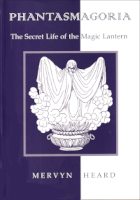Price £20.00 (£15.00 to MLS members)
Mervyn Heard, Phantasmagoria: the Secret Life of the Magic Lantern
Hastings: The Projection Box, 2006
ISBN 978-1903000-12-0
312 pages, paperback, 17.5 x 25cm

Ghosts of the departed, and apparitions of lost friends, appeared as if by supernatural forces to the audiences of the earliest Phantasmagoria presentations in the late 18th century. This account offers a comprehensive history of such spectral apparitions from ancient times to today, particularly the use of the magic lantern to project images of phantoms.
Making an important contribution to projected image history, Phantasmagoria is based on two decades of original research, yet is one of those rare works that manages to be both learned and accessible. It’s an entertaining book, written with a lively style and a turn of phrase closer to a showperson’s patter than to a heavyweight historian’s prose.
It presents significant discoveries on pioneering phantasmagores like Schröpfer and Philidor, and traces the evolution of different phases of the phantasmagoria across time and national boundaries. Aspects like the Masonic connections of early Continental shows, fractious relationships with the French Revolution, the rush in the English provinces to cash in on ‘the latest thing in London’, or the tentacles which it extended into later upstart media like the moving picture, illustrate clearly and enticingly that the phantasmagoria was never homogenous or constant. Like all entertainment media, it shifted and changed as it passed from one pair of inventive hands to the next.
Perhaps most engagingly, the tales of the early phantasmagores and their shows are told by someone who understands what it takes to give a successful performance. Mervyn Heard brings to his descriptions a showman’s knowledge of what does and doesn’t work with an audience, and an understanding that any performance medium is a movable feast.
